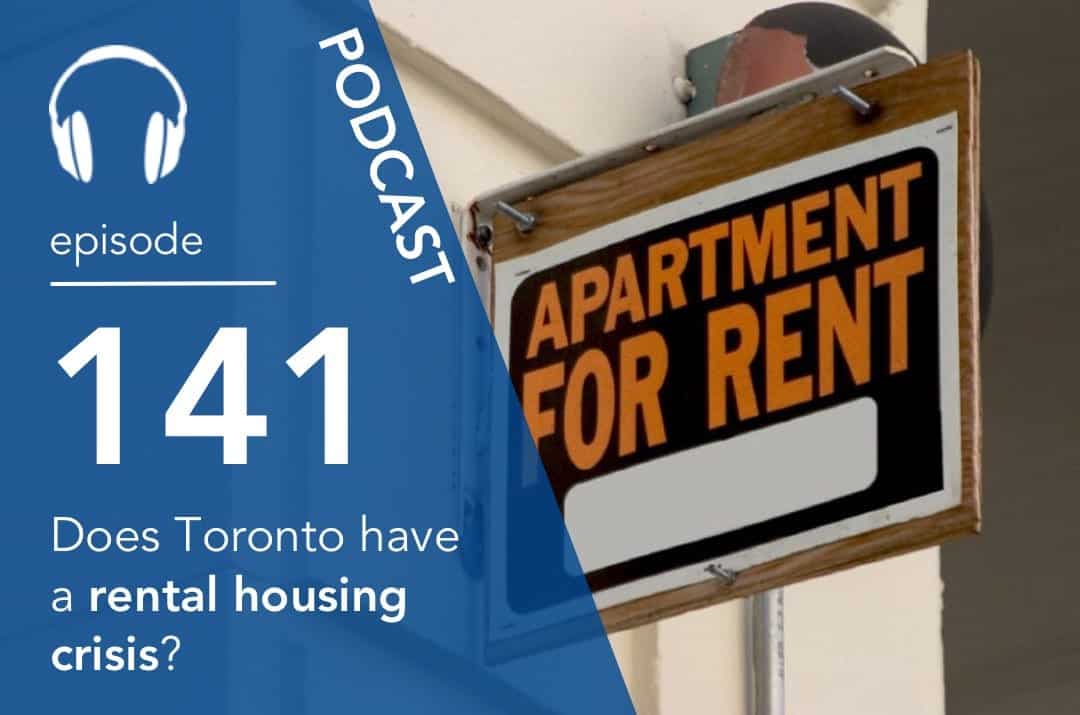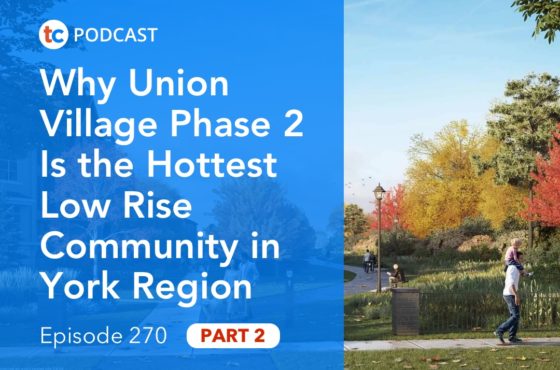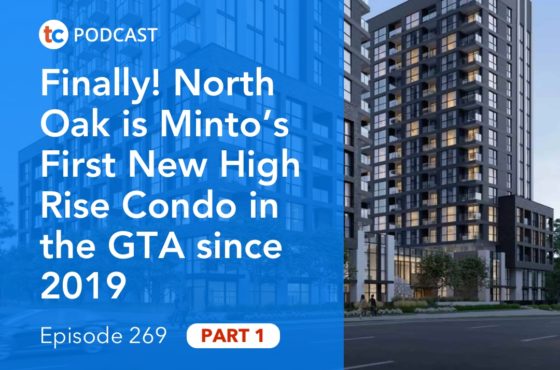Does Toronto have a rental housing crisis?

There has been a lot of sensationalized stories in the media recently about the Toronto rental market. Could rents really be going up by 100% per year as some stories have suggested? Do we currently have a rental housing crisis? Is there even a problem at all, and are rent controls the solution? Where should condo investors be investing now? Find out what Shaun Hildebrand of Urbanation has to say as we discuss Urbanation’s Q1 rental market report.
SHAUN HILDEBRAND INTERVIEW HIGHLIGHTS
3:30 Experiencing higher levels of purposeful rental development.
4:15 Market under supplied and rent growth at 8%.
5:35 What is actually happening in reality with the rent growth?
7:35 Thoughts on what the government is going to do about happenings in the market.
7:50 Purpose built rental development.
17:00 What are some of the existing trends that you’re seeing continuing in the data?
21:00 Couple of projects that showed value.
Click Here for Episode Transcript
Speaker 1: Welcome to the True Condos Podcast with Andrew la Fleur. The place to get the truth on the Toronto condo market and condo investing in Toronto.
Andrew la Fleur: All right. It’s my pleasure to welcome once again back to the show, Shaun Hildebrandt, of Urbanation. Shaun is a Senior Vice President there at Urbanation. Happy to have you again on the show, Shaun.
Shaun H.: Thanks for having me.
Andrew la Fleur: Yeah. It’s always good to chat and hear your take on the market. I don’t know if anybody knows the condo market better than you because this is what you do every day. Let’s talk about the latest report that you guys have put out last week, the Q1 rental report. The results are in from the first quarter, but let’s set some context before we do that.
As you said in your email that you sent out with the report, there’s been a lot of chatter in the media and from the government about the current state of the housing market, of course, in general, but specifically the current state of the rental market.
We’ve had a few stories of tenants who say their rents have been increased by 100%. This is causing great consternation and gnashing of teeth as it were at Queens Park. Are rents in Toronto going up by 100% a year?
Shaun H.: No, not at all. I think that was the message behind the latest data that we released. Rents are growing quicker than they historically have, but by no means are they doubling as some of these stories have suggested. Our data showed that on average, condo apartments leased through the MLS system in the first quarter, grew by just over 8% in terms of average rent over a year.
It’s above average, for sure, but it also marks a slowdown in the rate of growth that was recorded in the fourth quarter of 2016, which was at an annual increase of closer to 12%. The market is showing a bit of moderation and that really has to do with some increases in supply, the new condos that have come to completion over the past six months.
This additional supply has helped to slow down the rate of increase in rent, created a little bit more balance in the marketplace. We saw the average days on market go up a bit. We measured the percentage of units that are being leased for over asking rents and that came down quite a bit.
In the fourth quarter of 2016, close to 20% of all units were leased above the asking price. In the first quarter, it was less than 10%. The market is self-stabilizing, I would say. I think that’s a trend that’s going to continue over the next few years.
There’s still quite a few condo apartments that are under construction and will come to completion over this three year period. That’s really where most of the new rental supply comes from.
We are experiencing higher levels of purposeful rental development as well, which will help to temper rent growth in the next years, but I think still we’re going to be relying mostly on growth in the condo sector to come in and keep a moderate pace of rent growth.
We’re expecting that that trend is going to continue and we’re not going to be seeing double digit rates of increase for condo rent and certainly not 100% growth in condo rents as is suggested by a couple of these isolated stories.
Andrew la Fleur: You’re saying we don’t have a rental housing crisis in Toronto?
Shaun H.: In terms of crisis, I would say that the market is under supplied, for sure. Rent growth at 8% is still above normal. When you look at same sample rent growth, which looks at the same sample of buildings in both periods and exclude the impacted new units coming into the marketplace, the annual rate of growth was 5%.
It’s not nearly as high as suggested by the headline number, but it certainly is growing faster than I would say, obviously, the general rate of inflation and historical average growth of around 3% or so. It does suggest that the market is tight, for sure, but I don’t think it’s reflective of massive rent increases that are being passed onto tenants from overly-aggressive landlords.
Andrew la Fleur: Just to recap, I mean, these particular stories, in explaining what is actually happening, these stories we hear where rents are going up by 100% for the odd tenant here-and-there that has notified the media and written a story about it, how do you explain that particular situation? I mean, obviously, you don’t know the specific details of it, but what is actually happening there in reality?
Shaun H.: Yeah. We don’t know the individual circumstances behind each of these outlandish increases, but what we try to do is we put it into context. Yes, rents are growing faster than normal, but they are not growing by that expense across the widespread market. If you look at rent growth, even just over the past few years, it’s growing from a pace that was pretty much neutral for a good period of time.
The headline didn’t come out when rents were flat for a few years between 2013 and 2015. During that period of time, our statistics were showing that rents were pretty much not growing for a period of three years. Now, they’re starting to grow, but coming off of a very flat period, so the rate of increase is exaggerated.
When you average out rent over the past three, four, five year period, they’ve only really been growing at an annual pace of still about 3%, even capturing this latest increase in rent. I don’t think that the market has seen expected growth in rent. If you compare rent growth to housing price growth, really rents are rising at a fraction of what’s happening in the ownership market right now.
The market for rents has been much more stable. The increase that we saw in 2016 was, I would consider, a short term deviation away from a longer term trend of really a modest case of rent growth.
Andrew la Fleur: Right. I don’t know if you’ve been involved with the discussions with the government or if they’ve consulted you or your firm at all in what’s happening in the market, but what is your feeling or what is your thoughts on what do you think the government is going to do?
Everybody’s wondering and the government’s dropping all sorts of hints but they’re not telling us any specifics as to what they may or may not actually do to effect the housing market and the rental market specifically.
Just wondering what your thoughts are on what you think the government may do? Then, a second part to that question, specifically with all your clients who are in the purpose built rental side, what are the purpose built rental developers, what’s their take on the situation as well? What’s their message to the government?
Shaun H.: Well, I think the messaging that’s come out thus far from the Provincial Government in particular, is that they feel that there is some sort of need to introduce regulation as it relates to rent growth. My feeling is that this is in direct response to a few news article that got a lot of media attention as you referenced earlier without looking at the full context of what’s happening across the broader rental market.
I think that’s an issue. I don’t know exactly what sort of regulation will come in. Probably rent control, at some sort of magnitude will be introduced, but I don’t know if there’s going to be an exemption for new units that are being built during any certain period of time or whether the cap is going to be at inflation or inflation plus a percentage bump above that. I really don’t know, but the messaging that’s come out has been fairly clear that some sort of regulation is probably on the way.
I don’t think that it’s necessarily justified. Sure, as I mentioned, rents are accelerating but for the most part, they’ve basically been rising, in line, or just slightly above inflation. This is, after several years of happening, has brought the market to a point where it’s starting to make sense finally for purpose built developers to come in and introduce new supply through new construction.
What’s most important for them is being able to hit that initial rent. They’re looking at the rents that are being achieved in new condo apartment projects in the city and they’re plugging those into their performance listing that the numbers are starting to make sense. If they’re able to lease up at the same rates or slightly above the rates that are being achieved by new buildings today, then it’s going to start to make more sense to start to build.
I don’t think that they’re anticipating huge increases in rent but at the same time, if they know that they’re only going to be able to increase their rents by inflation, then they’re probably going to start to think twice about moving ahead with these projects. Or, they’ll switch gears and maybe proceed as a condo project or position the product differently so they’re able to achieve a higher initial rent than they otherwise would.
The conversations that we’ve had with those that are planning to build purpose build developments projects is that rent control wouldn’t necessarily be a killer for their projects, but if it’s introduced in conjunction with an incentive to help make the economics more feasible for them, which would be increased density, perhaps lower taxes, interest-free loans or something like that for a period, something that would help mitigate that increased regulation for rent control, should help make the project feasible.
If the rent control came in as it applies right now to the buildings that have been constructed before 1991, which is basically the regulation, then I think a lot of them would probably put their projects on a shelf. If they take an example of say, Vancouver, where rents are able to rise at inflation plus 2 percentage points, plus a percentage of the increase in operating expenses, then I think it provides a balance for the developers and the tenants to offer some sort of protection in them knowing that their rents aren’t going to double, but also providing instant realistic guidelines for developers to be able to grow their revenue.
Andrew la Fleur: Right. Right. That’s really interesting just to hear again. There’s a perspective that I feel like it needs to get out there and we’re not hearing from the people who are investing hundreds of millions of dollars into purpose built rentals, what their expectations are on the market.
I mean, like you said, they’re not coming into these markets thinking, just rubbing greedy little hands like some cartoon character, like, “I just can’t wait to raise my rents every year by 100%,” or something like that.
It’s just really unfortunate that one or two stories has taken hold of the headlines and of people’s understanding of the rental market when it’s just complete distortion of what’s actually happening.
Especially, like you said, just look at the numbers. Forget about this quarter and last quarter, just look at the rest of the numbers over the last five years and you quickly see that the rental market is, like you said, it’s appreciating just a little bit above inflation. It’s nothing even remotely close to what is happening in the low rise housing market where you’ve had double digit increases year-after-year-after-year-after-year.
Shaun H.: That’s right. If anything, we should be encouraging developers to add supply in some sort of way. It seems right now that the right way to do that is through purpose built rental development. We’ve been tracking a growing pipeline of projects that are proposed for development.
It up at around 30,000 units right now. Only about 30% of those are actually approved, so I think we need to get those approval numbers up. I think we need some clear indication from the government about which way they’re going to be moving with respect to regulating the market.
It’s particularly concerning that we’ve seen purpose built rental construction actually decline over the past 12 months. The beginning of 2016, we’ve only seen about a thousand units start construction. It might sound like a lot, but it’s actually below levels that we’ve seen over the past decade, which were, even of themselves, low numbers, range between 1,000 and 2,000 units a year.
The fact that we have this growing supply pipeline of proposals but construction starts are starting to drop off, suggests to me that we’re going to be looking at an even more severe supply situation in a few years’ time. I don’t think we can rely on condos to continue to supply the market as they have.
Like, you know as well as I do, that new launch activity, particularly in the Core, where most of the rental supply comes from, has dropped off dramatically. New project launches for condos in the former city of Toronto, dropped by 40% last year.
There’s about a five year time lag between project launch and completion, so by the time we get to 2021, 2022, we’re going to be faced with a dramatic pull-back in condo apartment deliveries.
It’s at that point in time, that we need to start to see purposeful rental development pick up. The fact that the government is looking to impede that by implementing some sort of a regulation that would cause developers to think twice or perhaps not go ahead at all with their rental development project, is concerning, because I think it’s short-sighted in the fact that we just have come to expect that the market will be supplied by individual condo investors.
I think the numbers are showing that look. These launch or volumes have dropped off a lot even though there’s a lot of units under construction right now. In a few years’ time, that inventory is going to be greatly diminished. If you think that vacancy rates and supply is low now, just wait five years from now and see what happens if we don’t start to see purposeful rental development pick up.
Andrew la Fleur: Very interesting, yeah, again. Understanding the bigger picture and understanding that the decisions we make today have an effect three, four, five years’ out. Shifting gears, Shaun, to the actual rental report and looking at the data itself, I’m wondering what, in terms of trends, speaking about trends in the rental market. If you could highlight one or two things for us perhaps from the report, in terms of maybe think about it like this.
What are some of the existing trends that you’re seeing continuing in the data and are there any new trends or new things to watch moving forward, maybe it’s particular areas, particular unit types, increasing or decreasing in popularity, those kinds of things? Are there any existing trends that you’re seeing continue in the data or there are there any new trends that you’ve seen pop up in this latest report?
Shaun H.: I think the clearest trend that we’ve seen is the emergence of a strong rental market in the 905. A lot of activity happening in the suburban market and projects getting rent levels that were surprising to us in a lot of cases, not only through condos, but even some of the newer purposeful rental projects that have come to completion.
There was a project that completed in the first quarter in Oshawa that was leasing at like $2.60 a foot, which is extremely high for that area. We’ve seen new condo apartment projects that are coming up in Markham and Vaughan and Mississauga getting above $2.50 a foot for the first time.
I think it’s providing some signals, again to developers. It’s starting to make a bit more sense to think about these markets in terms of new rentals as opposed to condos in some cases.
These markets seem to be doing very well within the smaller unit types. These are markets that are catering to really a market that didn’t see supply for several decades and particularly supply catering to single persons. These individuals that have been priced out of even the condo market in some cases are increasingly turning to rent and we’re noticing that the smaller units, even though they’re located in suburban markets, are doing quite well on a [prospective 00:18:58] basis.
The historical relationship between small unit size and high rent per square foot that was exhibited in Toronto, is starting to play out in some of these suburban markets. Now, what’s interesting is that in the City of Toronto, which is obviously a much more mature rental market than the 905, we’re starting to see that the larger units are getting the higher rent per square foot.
We did an analysis of the entertainment district. We pulled out all the leases that occurred in the first quarter in the entertainment condo market and compared those to the first quarter of 2016. What we saw that the smallest units were still getting premiums in terms of rents per square foot. We did notice that the two bedrooms, and the two bedrooms plus dens, were seeing well above average growth of 10, 12%, yearly yield growth in rent, whereas the one bedrooms were growing at about 8%.
The market is strong all around, but we have noticed that these larger units are getting increasingly higher rents per foot and growing at a faster pace than some of the smaller units. I think that normally goes back to what’s happening in the ownership market. Not as many first time buyers getting in.
In most cases, well-qualified buyers, but they’re not finding what they’re looking for and increasingly turning to larger rental units. We’re seeing that this is playing out quite clearly in terms of the demand-and-supply dynamics in the marketplace.
Andrew la Fleur: Very interesting. Are you saying that if you’ve an investor looking to buy now that the two bedrooms units are potentially the play to make as opposed to the smaller unit?
Shaun H.: I think so. I was actually surprised to see that some of the new projects that registered in the first quarter with smaller units didn’t do as well as I thought they would whereas the larger units within these projects actually did better than expected.
There was a couple of projects that showed value. Core Condominiums and Studio 2, which was in the entertainment district, which had fairly small unit sizes, but didn’t achieve their rents that I expected. Now, these are initial rents, so they tend to rise after that initial bump supply that comes into the market, but nonetheless, they didn’t see the same rates of rent that some of the previous projects that registered in these areas did achieve.
I was looking at some of the larger units within these buildings and I always think, “Wow! They’re actually getting higher rents, in some cases, than the smaller units.” It’s an interesting dynamic that’s starting to play out.
I think, yeah, looking at that as sort of an investment, the two bedroom units, which are in shorter supply, are probably going to be appreciating faster than the smaller suites. I think just, in general, the home ownership rates are going to start to flat line and that as the demographics continue to age, you’re going to see increasing levels of demand for two bedroom suites and people able to afford high levels a lot easier.
Andrew la Fleur: Very interesting. Yeah, definitely a trend that we’ve been seeing as well and something to watch for. Shaun, it’s been great chatting with you, as usual. Thank you very much for your time today and your insights. Really appreciate it.
Once again, if people want to get ahold of you or learn more about Urbanation and the services that you offer, what’s the best way to do that?
Shaun H.: You can check out our website, urbanation.ca. We’re actually going to be rolling out some new reports that are going to be of particular interest for investors. In the coming weeks, if you visit the website, you’ll be noticing a new portal where you can go and download individual market reports on each of the sub-markets that we track across the GTA.
In a ten-page report, you can get a full state of the nation of what’s going on in that particular sub-market and full data sets for new construction, resale, rental and anything that’s in the proposed pipeline as well. I think it’s a useful tool for anyone that’s looking to invest in the market. Again, something that’ll be offered very soon on the website for download.
Andrew la Fleur: That’s great. Sounds excellent. We’ll definitely watch for that. Thank you very much, Shaun. We’ll talk to you again soon.
Shaun H.: All right. Thank you.
Speaker 1: Thanks for listening to the True Condos Podcast. Remember, your positive reviews make a big difference to the show. To learn more about condo investing, become a True Condos subscriber by visiting truecondos.com.



